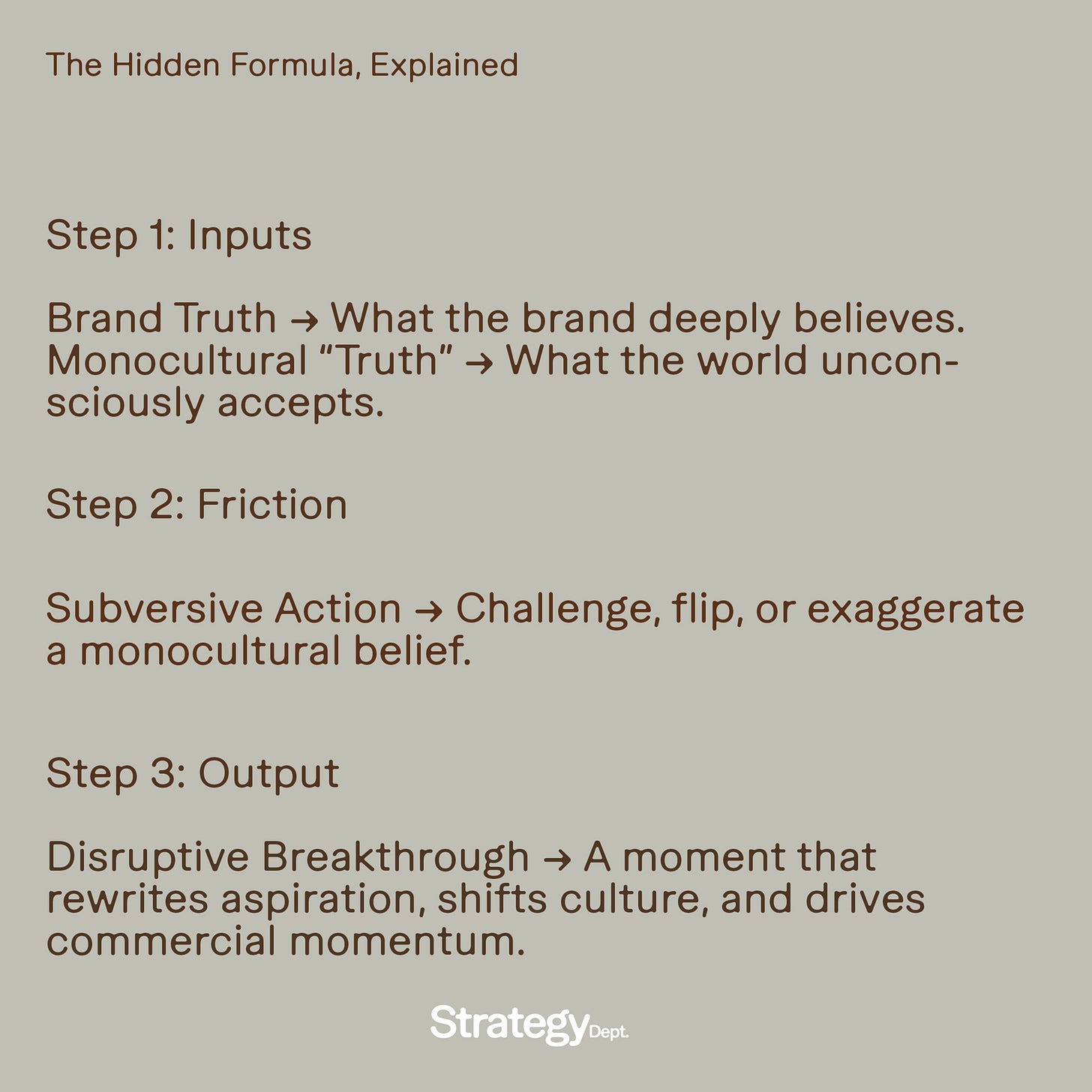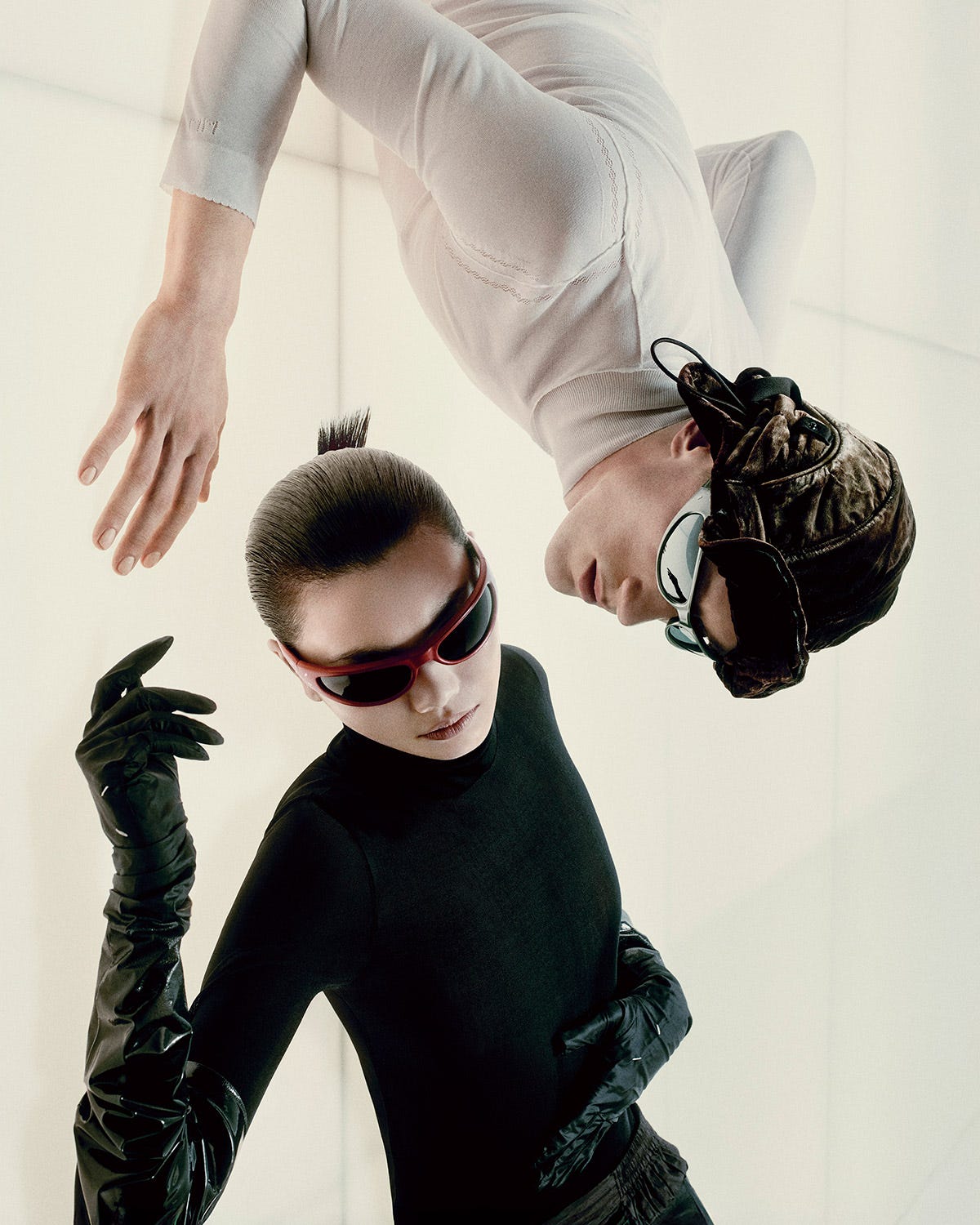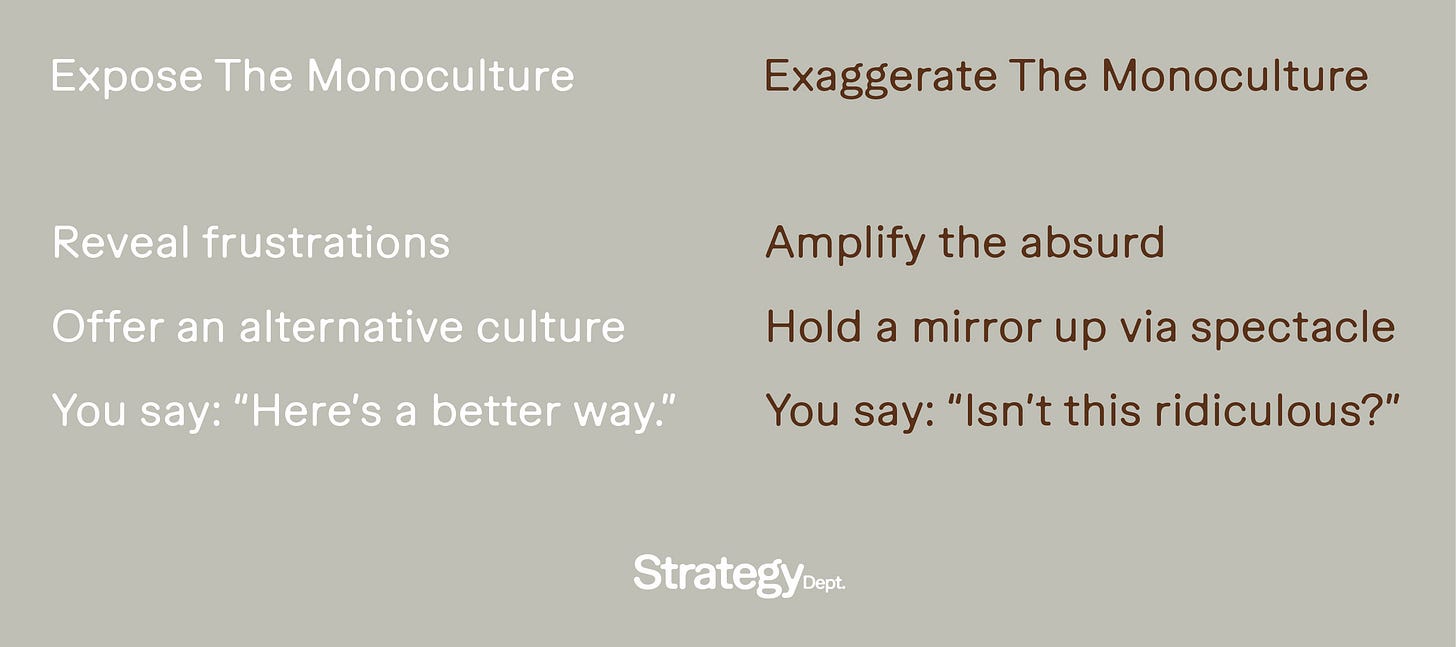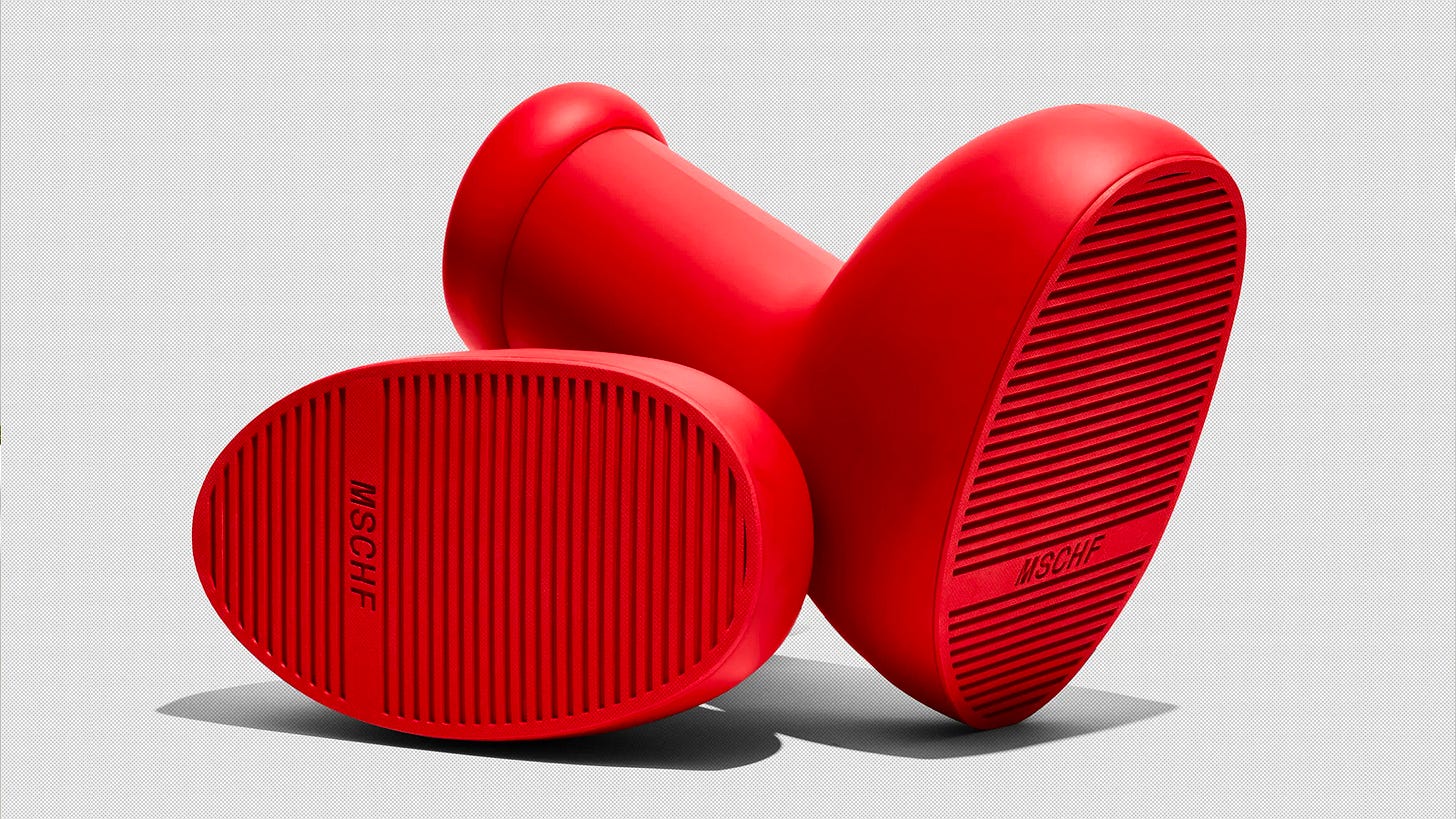A version of this thought piece debuted last week on —the brand strategy newsletter that first inspired me to start my own. Shout out to full circle moments.
Why do certain things in culture catch fire?
A phrase, a product, a show, a campaign—somehow they break through. They flood social feeds, dominate group chats, and suddenly feel like they were always a part of our collective consciousness. Not just popular, but beloved.
What makes something take off? Is it timing? Aesthetic? Luck? Or is there a deeper pattern that explains why certain ideas resonate while others fade into the scroll?
Brand marketers and creative agencies try to manufacture this kind of fame all the time, and often miss the mark. So what sets true breakthroughs apart?
More often than not, the most resonant ideas don’t just ride culture—they subvert it. In both direct and subtle ways, they challenge the unconscious norms shaping aspiration, taste, and desire. Through their very existence, they offer new scripts for what’s next.
This article unpacks what I call the Hidden Formula: a strategic framework for generating this kind of cultural traction and visceral resonance. It reveals the invisible forces behind ideas, products, campaigns, and people that strike a cultural nerve—spreading faster, embedding deeper, and delivering real commercial impact. It’s what marketers really mean when they say they want to “make cool sh*t”: not just hijacking attention, but cracking something open and creating something that feels both novel and necessary.
And it starts with a simple truth: To invent the future, you have to subvert the present.
And the present is shaped by a force few are trained to see: the monoculture.
Understanding the Monoculture
The monoculture is the dominant system of beliefs that people unconsciously accept as truth. It reflects collective morals, values, tastes, obsessions, and general approaches to living.
It’s easy to name the monoculture of Japan during the Edo Period or America in the Roaring Twenties. It's harder to recognize the one we’re living in, precisely because we’re inside it.
Today’s monoculture isn’t defined by one ideology or aesthetic. It’s fluid, fast-moving, and fractured, held together by shared reference points that feel ordinary until you step back and see them for what they are: a constantly shifting stream of hypernorms.
Here’s just a glimpse of what defines the present moment:
Botox, Ozempic, and biohacking
Red light therapy and cold plunges
10-step routines and emotional support water bottles
Doomscrolling, dopamine addiction, and ghosting
OnlyFans, parasocial relationships, and “the personal brand”
Dupe culture, TikTok Shop, and AI everything
Non-alcoholic aperitifs and Instagram therapists
This is the cultural air we breathe. A monoculture dictates what’s aspirational vs. ordinary, tasteful vs. cringe. It tells us that Comme des Garçons Chuck Taylors and tight jeans are cheugy. That J. Lo can be untouchable one minute, delusional the next. These 'truths' shift constantly, shaped by tech leaps, viral trends, celebrity drama, meme logic, and blockbuster moments.
The problem isn’t change—it’s our lack of awareness. Like frogs in boiling water, we absorb new ideals unconsciously, reshaping our values without realizing it. In the early 2000s, Botox was seen as extreme. Today, it’s a non-event.
Brianna Wiest puts it best:
"Once you have deeply accepted an idea as ‘truth,’ it no longer registers as ‘cultural’ or ‘subjective.’ But maintaining objectivity is crucial. So much of our inner turmoil comes from living a life dictated by norms we never consciously questioned."
When we accept monoculture as absolute truth, we become sheep.
Brands and the Monoculture: Mirror or Disruptor?
In a capitalist framework, brands don’t just operate within the monoculture—they help shape it, alongside media and celebrity influence. Advertising defines modern aspiration. Most marketers mirror what’s already trending to feel relatable, chasing engagement through monoculture mimicry.
The monoculture is an easy source of inspiration because it’s right in front of us. It requires no historical context or cultural analysis. You don’t have to zoom out; you just have to react. Case in point: the dominance of brain rot marketing—a flood of fast, irreverent, algorithm-optimized content tailored to Gen Z’s shrinking attention span. Everyone from Nutter Butter to Ryanair jumped on the trend in a bid to stay relevant. But simply amplifying the present creates a sea of sameness, and a vacuum where the future and novel thinking should be.
Brooklyn-based art collective MSCHF describes this phenomenon:
"No one talks about the future anymore. Instead, everything accelerates the present to a fever pitch, intensifying and weirding the dysfunctions of the current moment. There’s a hole where the future used to be, and all that remains is the increasingly spicy present."
This presents both a challenge and an opportunity for brands:
Reinforce the monoculture.
Or resist and reshape it.
The latter is what sets culture-shaping brands apart. When the world moves in one direction, standing still or choosing another path becomes a radical act.
Take Patagonia, every marketer’s perennial case study. In 2011, they ran a full-page New York Times ad on Black Friday with a blunt headline: "Don’t Buy This Jacket." At the peak of holiday consumption, the campaign urged customers to think twice before buying, spotlighting the environmental cost of overconsumption.
The result? Patagonia didn’t just protect their credibility; they expanded it. Sales increased. The campaign became a landmark moment, positioning the brand as the moral compass of the outdoor industry. It wasn’t just a marketing stunt. It was a values-driven provocation that rallied customers and employees alike, and helped spark a broader wave of ethics-led branding, from REI’s #OptOutside to today’s slow fashion movement.
The lesson: Culture-leading brands don’t mirror the monoculture. They interrogate it, and invite others (e.g. their competitors, their core customer) to do the same.
Breaking Down: The Hidden Formula
When you study the brands, products, people, and campaigns that actually move culture, a clear pattern—one hiding in plain sight—emerges. I call it the Hidden Formula:
It’s a strategic framework for how brands can disrupt monoculture by amplifying their brand truth—turning that disruption into a magnet for true fans. The Row, for example, banned social media at their runway shows, deepening their appeal to a discerning audience weary of constant exposure.
By creating friction between what they believe and what the world accepts, brands can spark moments that shift culture and accelerate their relevance. Here's how it works:
By leveraging this formula, brands aren’t just selling an idea. They’re signaling what they stand for. The most culturally resonant brands use subversive action to expose a tension or contradiction within the monoculture. In doing so, they awaken consumers to a deeper, often unspoken, shared truth.
This kind of cultural intervention doesn’t just build hype. By reinforcing values and lifestyles that stand in contrast to dominant norms, they offer consumers an alternative script—one that feels more intentional, more aligned, more them. This is how you build a tribe, and ultimately, commercial success.
Take Aimé Leon Dore. Rather than reject prep culture—a space historically associated with white affluence and elite institutions—ALD reclaims it. The brand blends classic American sportswear with NYC street codes, Black and immigrant cultural references, and luxury flourishes. The result is a new kind of prep—one that expands the script for a cooler, more culturally attuned consumer who never quite saw themselves in Ralph Lauren or Polo.
By rejecting dominant norms and offering an alternative, ALD doesn’t just build cultural cachet. They become the blueprint for a different way to live, dress, and think. In a world of passive consumption, the brands who leverage the Hidden Formula awaken the sheep. They lead while others follow, inviting early adopters into the fold—not just as fans, but as the foundation of an aspirational customer base.
Disruptive Breakthroughs in Action
This formula works across categories: brands, entertainment, even individuals. Whether it’s a designer, a podcast, or a pop star, the biggest breakthroughs tend to follow the same pattern. They name a dominant cultural belief, then subvert it with a bold alternative.
A few standouts:
Maison Margiela—In the late ’90s, when fashion was dominated by loud logos and personality cults, Margiela embraced anonymity. Faceless models, deconstructed garments, and tagless designs turned mystery into meaning, setting the stage for a new kind of intellectual minimalism.
Tesla—Before Tesla, electric vehicles were seen as slow, unfashionable, and niche. Tesla reframed EVs as fast, sleek, and high-status, turning environmentalism into a flex and launching the era of tech-luxury driving.
Ghia—Sobriety is often framed as lonely or punitive. Ghia repositions it as design-centric and communal, offering the rituals of drinking without the aftermath, wrapped in a brand world that whispers the south of France.
Call Her Daddy—Most celebrity interviews are carefully choreographed. Alex Cooper showed up in sweats and asked guests about their favorite sex position. Her raw, peer-to-peer tone created a new kind of cultural authority for Gen Z women.
Alex Consani—For decades, models were meant to be seen and not heard—mysterious, silent figures for audiences to project onto. Alex Consani, named Model of the Year in 2025, shattered that mold with memeable chaos. Her rise proved that being "chronically online" could be not just accepted, but deeply relatable.
Two Modes of Disruptive Breakthroughs
The Hidden Formula often hinges on how a brand engages with the monoculture. Some brands expose its flaws by rejecting the dominant narrative entirely, offering a new script where none existed. Others amplify the monoculture to the point of absurdity, holding up a mirror through exaggeration.
Think of it as two modes of cultural intervention:
“Expose” Case Study: Equinox We Don’t Speak January
Every January, gyms flood with resolution-fueled optimism. New Year, new me. It’s a monoculture ritual built on guilt—one that most fitness brands exploit with sign-up deals, free trials, and transformation promises.
Equinox did the opposite.
On January 1st, 2023, the brand locked its digital doors. No memberships. No discounts. Just a blunt message: “We Don’t Speak January.”
The campaign disrupted a predictable cultural script—exposing the performative churn of New Year’s resolutions and the self-help industrial complex that profits off short-term shame. By refusing to participate, Equinox reframed discipline as a year-round commitment, not a seasonal fad.
Of course, it sparked backlash. But also headlines, admiration, and loyalty from core members who saw their own quiet self-discipline reflected back. In rejecting the monoculture of transformation season, Equinox doubled down on their ethos and attracted those who shared it.
”Exaggerate” Case Study: MSCHF Big Red Boot
In 2023, as fashion leaned into sculptural, exaggerated footwear, MSCHF pushed the trend to its breaking point. The Big Red Boot wasn’t just a product—it was a provocation.
Cartoonish, impractical, and deliberately absurd, the boot blurred the line between digital fantasy and physical reality. Its release collided with a growing fascination for odd, oversized silhouettes, stretching fashion’s impulses until they tipped into self-parody.
By holding up an outsized mirror, MSCHF exposed how far style had drifted from function, turning status signaling into pure spectacle.
Applying the Hidden Formula to Your Brand
If you want to create disruption that resonates culturally and commercially, start by asking yourself three essential questions (in no particular order):
Know Thyself
What would your brand fight for—even if it cost you customers?Spot the Monoculture
What norms or expectations in your category have gone unquestioned for too long?Pick Your Punch
What’s something in your industry you—or your customer—would love to punch? (A principle borrowed from Cindy Gallop—because some rules were made to be broken.)
Remember: the best breakthroughs don’t emerge from novelty for novelty’s sake. They happen when a brand’s deep truth collides with a cultural blind spot and rewrites the script. In the end, the brands that move culture forward are the ones that see aspiration not as a mirror, but as a provocation—a way to rally the audiences who truly share their values.
P.S. Next month, I’m opening up my books to take on a few new 1-on-1 advisory clients.
In my consulting practice, I work directly with founders—particularly those building a brand from scratch or looking to refresh an existing one. I’ve developed a working curriculum that combines the thinking in The Hidden Formula and The Brand Universe Framework to help sharpen brand positioning and identify + ideate potential areas of subversion. If that sounds like something you’re navigating, feel free to reach out: alex@strategy-dept.com.
Acknowledgments
Thanks to Anthony Nitkowski, Founder of creative strategy studio 104 CLAREMONT, for his sharp eye and strategic input. I’ve collaborated with Anthony across several projects, and his ability to spot cultural shifts before they go mainstream helped shape key moments in this piece.











Kk. Understood 🫡
Great read, as always.